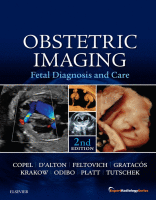Physical Address
304 North Cardinal St.
Dorchester Center, MA 02124

Introduction Duplication of the renal collecting system, also termed duplex kidney, is one of the few renal anomalies more common in females. Duplex kidneys have an upper pole and a lower pole, called moieties, each drained by a ureter. Approximately…

Introduction Fetal renal pelvis dilatation (or dilation) is a common ultrasound (US) finding, identified in 1% to 5% of pregnancies. There is a strong correlation between the degree of renal pelvis dilatation and the likelihood of postnatal urinary pathology, particularly…

Introduction Unilateral renal agenesis, also called solitary kidney, is a common congenital anomaly. Affected individuals are usually asymptomatic, and if a diagnosis is not made prenatally, they may not receive medical attention until complications arise. If unilateral renal agenesis is…

Introduction Bilateral renal agenesis is a uniformly lethal anomaly. Absence of the kidneys causes anhydramnios, resulting in pulmonary hypoplasia, characteristic facies, and positional extremity abnormalities ( Fig. 10.1 ). This constellation of findings was first described by Edith Potter, and…

Introduction The fetal kidneys are routinely imaged in the second and third trimester, but they are not usually measured unless an abnormality is suspected. Nomograms are available not only for kidney length ( Table 9.1 ) but also for anterior-posterior…

Introduction There are three types of abnormalities of renal location: simple renal ectopia (e.g., pelvic kidney), crossed renal ectopia, and horseshoe kidney. They are collectively termed renal ectopia . During normal development, the metanephros migrates from the pelvis to the…

Introduction Among rare thoracic tumors not described in previous chapters, two are the most common. Bronchogenic cysts are derived from abnormal budding of the ventricular diverticulum in the mediastinum or the lung. Lymphangiomas arise from the lymphatic system and develop…

Introduction The thymus is a lymphoepithelial organ with key adaptive immune functions during both intrauterine and extrauterine life. The thymus develops from the third pharyngeal pouch, which gives rise to endodermal-derived thymic cortical epithelium, and the third pharyngeal cleft, which…

Introduction Scimitar syndrome (SS) is a rare congenital anomaly characterized by a partial (usually the right lower lobe) or complete unilateral anomalous pulmonary venous drainage in association with ipsilateral lung hypoplasia. The anomaly, also known as pulmonary venolobar syndrome or…

Introduction Fetal hydrothorax is an intrathoracic effusion arising in the fetus, which may occur unilaterally or bilaterally, and may be primary or secondary. Disease Definition Fetal hydrothorax (also pleural effusion) is an intrathoracic effusion, which may occur unilaterally or bilaterally.…